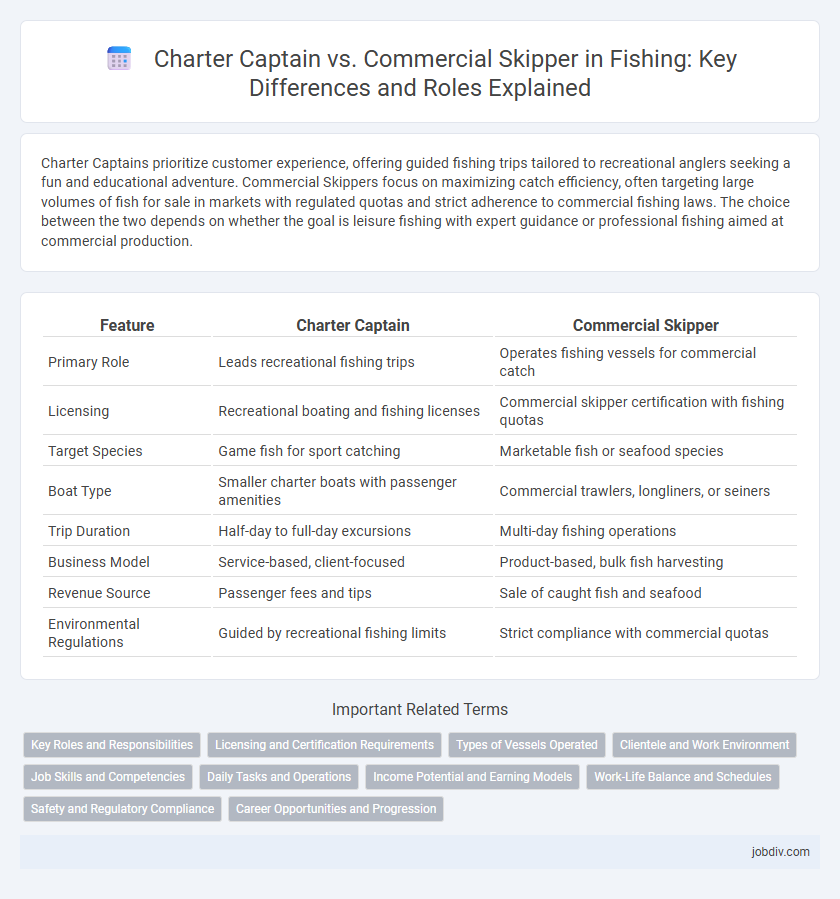Charter Captains prioritize customer experience, offering guided fishing trips tailored to recreational anglers seeking a fun and educational adventure. Commercial Skippers focus on maximizing catch efficiency, often targeting large volumes of fish for sale in markets with regulated quotas and strict adherence to commercial fishing laws. The choice between the two depends on whether the goal is leisure fishing with expert guidance or professional fishing aimed at commercial production.
Table of Comparison
| Feature | Charter Captain | Commercial Skipper |
|---|---|---|
| Primary Role | Leads recreational fishing trips | Operates fishing vessels for commercial catch |
| Licensing | Recreational boating and fishing licenses | Commercial skipper certification with fishing quotas |
| Target Species | Game fish for sport catching | Marketable fish or seafood species |
| Boat Type | Smaller charter boats with passenger amenities | Commercial trawlers, longliners, or seiners |
| Trip Duration | Half-day to full-day excursions | Multi-day fishing operations |
| Business Model | Service-based, client-focused | Product-based, bulk fish harvesting |
| Revenue Source | Passenger fees and tips | Sale of caught fish and seafood |
| Environmental Regulations | Guided by recreational fishing limits | Strict compliance with commercial quotas |
Key Roles and Responsibilities
Charter captains specialize in guiding recreational fishing trips, ensuring client safety, providing expert fishing techniques, and managing the boat for an enjoyable experience. Commercial skippers primarily oversee large-scale fishing operations, handling crew management, navigation, compliance with fishing regulations, and optimizing catch efficiency. Both roles require deep marine knowledge, but charter captains prioritize customer satisfaction, while commercial skippers focus on maximizing commercial yield and operational safety.
Licensing and Certification Requirements
Charter Captains must obtain a U.S. Coast Guard Operator of Uninspected Passenger Vessels (OUPV) license, commonly known as a 6-pack license, which requires documented sea time, passing a comprehensive exam, and background checks. Commercial Skippers operate larger vessels and need a Merchant Mariner Credential (MMC) with specific endorsements depending on vessel size and cargo type, alongside rigorous medical and security clearances. Both roles demand continuous education and regular certification renewals to comply with federal safety and operational regulations.
Types of Vessels Operated
Charter captains typically operate smaller, well-equipped vessels designed for recreational fishing trips, often ranging from 20 to 40 feet, featuring amenities for comfort and sport fishing gear. Commercial skippers manage larger, industrial boats such as trawlers, seiners, and longliners, built for heavy-duty fishing operations and higher catch volumes, often exceeding 50 feet in length. The distinct vessel types reflect the functional demands and business models of charter versus commercial fishing industries.
Clientele and Work Environment
Charter captains serve recreational clients seeking personalized fishing experiences, often operating in tourist-heavy or coastal leisure areas with a focus on customer satisfaction and safety. Commercial skippers manage crews on larger, industrial vessels targeting bulk catch for seafood industries, working in demanding environments with strict regulations and long hours at sea. Clientele differences drive distinct operational priorities: charter captains emphasize hospitality and guided tours, whereas commercial skippers prioritize efficiency and maximizing catch volume.
Job Skills and Competencies
A Charter Captain requires strong interpersonal skills to manage client expectations and ensure safety while providing an enjoyable fishing experience, alongside navigation and vessel handling expertise. In contrast, a Commercial Skipper emphasizes efficient crew management, regulatory compliance, and operational proficiency to maximize catch and maintain sustainable practices. Both roles demand in-depth knowledge of maritime regulations, weather patterns, and advanced fishing techniques, but the Charter Captain prioritizes customer service while the Commercial Skipper focuses on productivity and resource management.
Daily Tasks and Operations
Charter Captains primarily focus on guiding recreational fishing trips, managing small groups of anglers, ensuring safety, and providing an enjoyable experience through personalized fishing techniques and local knowledge. Commercial Skippers oversee larger fishing vessels, coordinate crew operations, handle navigation for extended voyages, and manage fish storage and processing to meet commercial quotas and regulations. Both roles demand strong maritime skills, but Commercial Skippers carry greater responsibilities related to vessel maintenance, regulatory compliance, and large-scale fishery management.
Income Potential and Earning Models
Charter captains typically generate income through daily or half-day rates charged to recreational anglers, with potential earnings varying seasonally and based on customer volume, often supplemented by tips and equipment rentals. Commercial skippers earn primarily from the sale of caught fish, with income dependent on catch volume, market prices, and operational costs, offering a more variable but scalable earning model. Understanding regional regulations and market demand is crucial for maximizing profitability in both charter and commercial fishing sectors.
Work-Life Balance and Schedules
Charter captains often enjoy more flexible schedules, allowing for a better work-life balance by choosing trips around personal availability and customer demand. Commercial skippers typically face stricter, full-time schedules with demanding hours driven by business needs and regulatory requirements. The charter industry's seasonal fluctuations offer captains opportunities for downtime, while commercial skippers work consistently to maximize catch quotas and meet market demands.
Safety and Regulatory Compliance
Charter Captains prioritize passenger safety by adhering to strict Coast Guard regulations and ensuring all safety equipment is up to date, while Commercial Skippers focus on compliance with fishing industry standards and environmental laws. Both roles require comprehensive knowledge of maritime safety protocols, but Charter Captains emphasize guest safety and comfort, whereas Commercial Skippers must navigate complex commercial fishing permits and quotas. Regulatory compliance involves regular vessel inspections, certified safety training, and maintaining accurate logbooks to prevent legal penalties and ensure operational integrity.
Career Opportunities and Progression
Charter captains enjoy career opportunities centered around guiding recreational anglers, requiring strong customer service skills and local fishery knowledge, with potential progression to owning charter businesses or expanding fleets. Commercial skippers focus on operating fishing vessels for commercial harvest, emphasizing navigation, crew management, and regulatory compliance, with advancement possible to vessel ownership or fleet management roles. Both careers demand maritime certifications, but commercial skipper roles generally offer higher earnings potential linked to larger-scale operations.
Charter Captain vs Commercial Skipper Infographic

 jobdiv.com
jobdiv.com